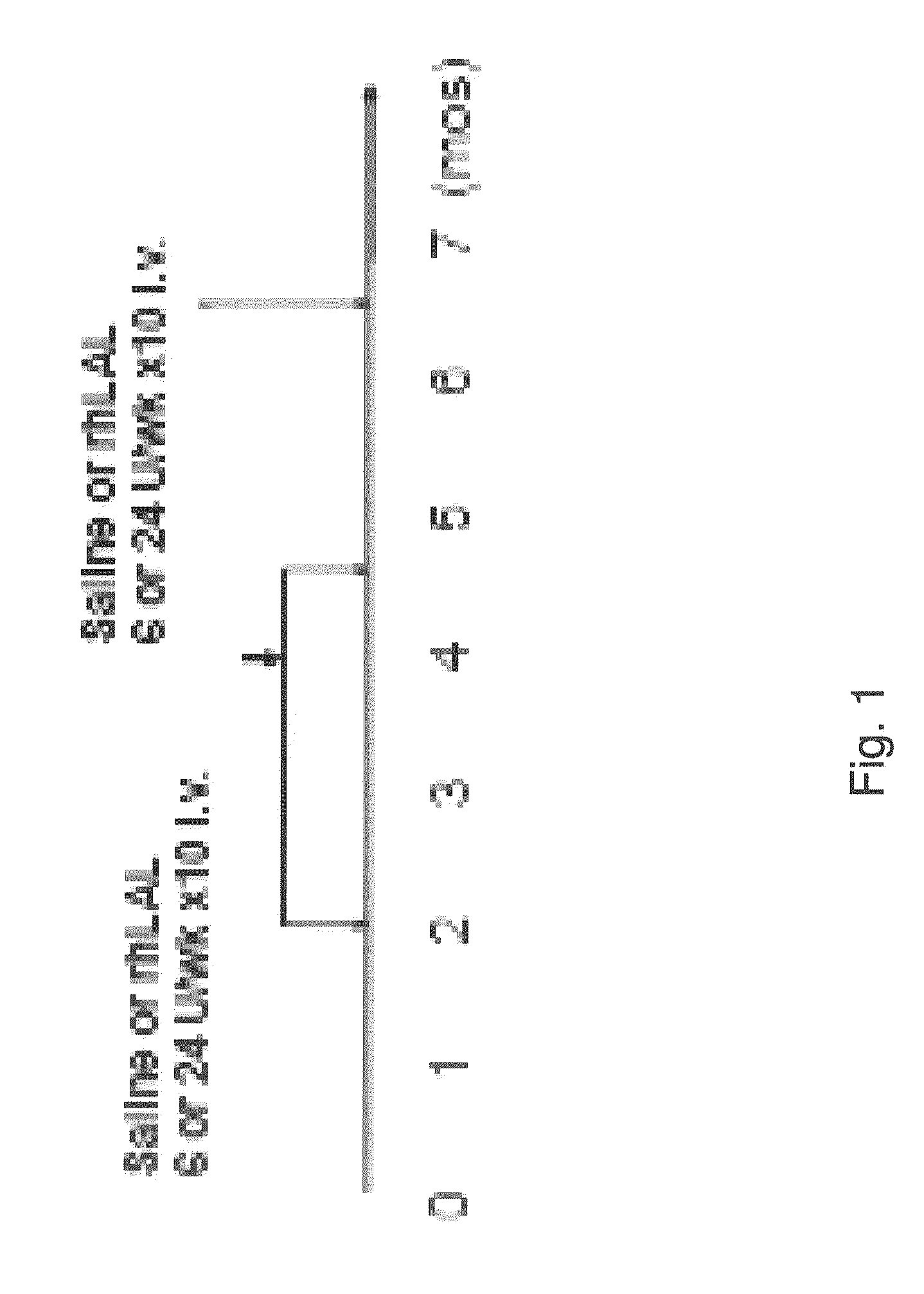Methods for Treating Lysosomal Acid Lipase Deficiency
a technology of lysosomal acid lipase and treatment method, which is applied in the direction of peptide/protein ingredients, biochemistry apparatus and processes, enzymology, etc., can solve the problems of fatty material build-up in various tissues, lal deficiency, etc., and achieve the effect of effective treatment and effective treatmen
- Summary
- Abstract
- Description
- Claims
- Application Information
AI Technical Summary
Benefits of technology
Problems solved by technology
Method used
Image
Examples
example 1
Production of Recombinant Human Lysosomal Acid Lipase (rhLAL)
[0107]Experiments described in this example show that recombinant LAL can be expressed and purified from mammalian cells.
[0108]Specifically, cultured human cells were transfected with a plasmid as provided above containing human Lysosomal Acid Lipase open reading frame by electroporation and cloned by limiting dilution. Stable clones were selected using cloning media containing 0.4 mg / mL G418. Clones were expanded and rhLAL expression and activity was analyzed using ELISA and LAL activity assays. Such methods are well known and within the skill of one of ordinary skill in the art.
[0109]In total, 384 clones were analyzed for rhLAL expression and activity. Clone 35 was determined to have the highest and most stable rhLAL expression. Expression in shake flasks was 3-4 pcd (picograms per cell per day) on average and expression in wave reactor was 4-6 pcd on average. Clone 35 was expanded and a cell bank was prepared.
[0110]Clon...
example 2
rhLAL Half-Life and Tissue Targeting In Vivo
[0113]The experiments described in this example show that rhLAL produced according to methods described herein has desirable pharmacokinetics and pharmacodynamics in vivo.
[0114]Recombinant human LAL (rhLAL) was expressed and purified as described in Example 1. Three rhLAL doses, 24 U, 48 U and 96 U (3.2, 6.4, and 12.8 mg / kg), were tested in lal− / − mice for pharmacokinetic studies by intravenous administration. Half-life values (t1 / 2) in sera, liver and spleen were determined for rhLAL at various doses. Half-life values (t1 / 2) of rhLAL in sera were 10 minutes for 3.2 and 6.4 mg / kg doses and 15 min for 12.8 mg / kg dose (n=5) (FIG. 4, top panel). Surprisingly, half-life values (t1 / 2) of rhLAL (a 6.4 mg / kg dose) in the liver and the spleen were 5 hours (FIG. 4, lower panels). A time course of liver rhLAL activity in mice injected with a single dose (48 U per mouse) intravenous injection of rhLAL was performed (FIG. 5). The t1 / 2 of both rhLAL en...
example 3
rhLAL Treatment Ameliorates Liver and Spleen Pathology
[0118]Experiments described in this example demonstrate that rhLAL can effectively reduce hepatosplenomegaly and lipid accumulation in various tissues. The mouse was used as an animal model.
[0119]As described above, lysosomal acid lipase (LAL) hydrolyzes triglycerides (TGs) and cholesteryl esters (CEs), as well as di- and mon-acylglycerols. Lysosomal Acid Lipase Deficiency (LALD) causes either an infantile form known as Wolman disease (iLALD) or a later onset form, known as cholesteryl ester storage disease (CESD or loLALD). The LAL knockout mouse model (lal− / −) resembles human LALD with storage of CEs and TGs in multiple organs, and loss of subcutaneous and omental fat.
[0120]In order to evaluate the effect of rhLAL treatment in liver pathology, animals received two different doses (0.8 mg / kg and 3.2 mg / kg) of rhLAL through tail vein bolus injection weekly for ten weeks in both young (2 months, n=25) and old (4 months, n=17) lal−...
PUM
| Property | Measurement | Unit |
|---|---|---|
| Fraction | aaaaa | aaaaa |
| Fraction | aaaaa | aaaaa |
| Time | aaaaa | aaaaa |
Abstract
Description
Claims
Application Information
 Login to View More
Login to View More - R&D
- Intellectual Property
- Life Sciences
- Materials
- Tech Scout
- Unparalleled Data Quality
- Higher Quality Content
- 60% Fewer Hallucinations
Browse by: Latest US Patents, China's latest patents, Technical Efficacy Thesaurus, Application Domain, Technology Topic, Popular Technical Reports.
© 2025 PatSnap. All rights reserved.Legal|Privacy policy|Modern Slavery Act Transparency Statement|Sitemap|About US| Contact US: help@patsnap.com



